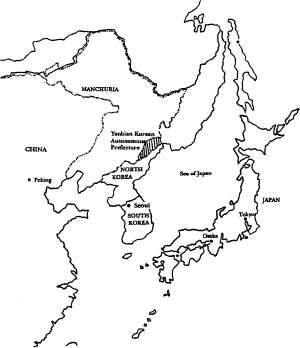This is a revision of a paper presented at the annual meeting of the Mid-South Sociological Association, Baton Rouge, October 18-22,1989.1 acknowledge thanks to anonymous reviewers of International Migration Review for providing helpful comments on the earlier version of this paper.
1881 1894 1904 1908 1912 1913 1914 1915 1916 1917 1918 1919 1920 1921 1922 1923
Number
|
10,000 |
|
531,857 |
|
65,000 |
|
513,973 |
|
78,000 |
|
542,185 |
|
323,808 |
|
558,280 |
|
238,403 |
|
557,052 |
|
252,118 |
|
597,677 |
|
271,388 |
|
607,119 |
|
282,070 |
|
630,982 |
|
328,318 |
|
672,649 |
|
337,461 |
|
673,794 |
|
361,772 |
|
719,988 |
|
431,198 |
|
968,484 |
|
459,427 |
|
1,056,120 |
|
488,656 |
|
1,145,028 |
|
515,865 |
|
1,300,000 |
|
528,027 |
|
1,414,144 |
Sources: Chae-JinLee, (1986):20.
A COMPARISON OF THE KOREAN MINORITIES IN CHINA AND JAPAN
FIGURE I Map of Korea, Japan, and China

The Chinese government established the Yanbian Korean Autonomous Prefecture in 1952, which gave institutional support to Koreans' cultural and political autonomy in the Yanbian area. In other parts of China, one Korean Autonomous District and 32 Korean Autonomous Villages were established in the 1950s (Hwang, 1986). Although Koreans constitute only about 40 percent of the total population of the Yanbian Autonomous Prefecture, they control the local government. Eleven of fifteen major government agencies and departments are headed by Koreans, and approx-
|
|
|
|
Number |
|
|
3,989 |
|
318,212 |
|
|
5,638 |
|
390,543 |
|
|
14,501 |
|
466,217 |
|
|
22,262 |
|
537,576 |
|
|
28,272 |
|
625,678 |
|
|
30,175 |
|
690,501 |
|
|
35,876 |
|
735,689 |
|
|
59,865 |
|
799,865 |
|
|
80,617 |
|
961,591 |
|
|
120,238 |
|
1,190,444 |
|
|
133,710 |
|
1,469,230 |
|
|
148,503 |
|
1,625,054 |
|
|
175,911 |
|
1,882,456 |
|
|
243,328 |
|
1,936,843 |
|
|
276,031 |
|
598,507 |
|
|
298,091 |
|
|
1986 "The Koreans in China." In The Current Status and Future Prospects of Overseas Koreans [in Korean]. New York: The Research Institute on World Affairs. Pp. 89-94.
1989b "The Quality of Life for the Koreans in Japan." Paper Presented at the Sixth Annual Meeting of the Conference on Overseas Koreans, Hong Kong.
1986a The Legal Status of the Koreans injapan and Human Rights Movement [in Korean]. New York: Research Institute on World Affairs.
1986b "My Visit to the Yanbian Korean Autonomous Prefecture," Overseas Korean [in Korean], 3:4-12.